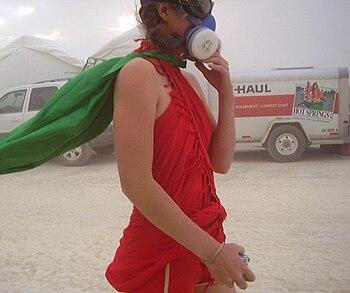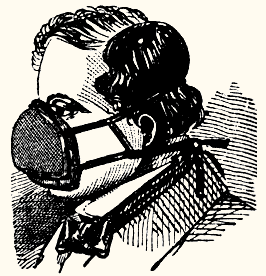The Professional Abatement Contractors of New York's (PACNY's) 19th Annual Environmental Conference started with lots of buzz and the conference did not disappoint. The conference had over 800 total attendees for the three days. The Vendor Exhibit Hall had over 25 exhibitors (an increase from last year) including a bunch of new exhibitors like
RJ Lee Group, US Micro, & the Zonolite Attic Insulation Trust added to the old standbys of Aramsco, DiVal, Fiberlock, & Grayling Industries. The conference organizer Deborah (Johnson) Sanscrainte, from Aramsco, did a fantastic job putting together the conference while also bringing a new life into the world. Lisa Brown was her beautiful self greeting everyone and registering the attendees (and commenting on men's hosiery). The conference planning committee went overboard putting this year's conference together. From our understanding the last day of the conference only came together a week or two before the conference.
 |
| Panorama View of the Vendor Hall from DiVal's Safety Ladder |
The first day of the conference which has become known as Proficiency Day and involved a new audience polling process that involved using the attendees messaging device to poll the audience. As usual it was very informative in learning anonymously what the audience's answers were on particular topics. This year the polling device was used for the entire conference (much better than last year's devices). Presenters included Diana Wolgemuth of Dale Carnegie (great take away was the 6 x 6 rule for slides); Kevin Malone of NYS Department of Health (NYSDOH); Andy Oberta of the Environmental Consultancy & Sean Hart of Energy & Environment, discussing "Visual Inspection: Comparing ASTM E 1368 and NYSDOL Rule 56". Mr. Malone filled us in on the 2014 training statistics - NYSDOH issued 27,790 certificates based on 3,481 courses that were held. In addition, Mr. Malone provided us with this link
http://www.gpo.gov/fdsys/search/home.action to find electronic copies of the most up-to-date federal regulations.
The second day of the conference was even better including presentations by Brent Kynoch of the Environmental Information Association (EIA); Linda Reinstein of the
Asbestos Disease Awareness Organization (ADAO) discussing "Asbestos - The Human Cost of Inaction" visit
slideshare for her presentation; Christopher Alonge from
Dormitory Authority of the State of New York (DASNY) and Matthew Darin from Bluepoint Environmental did a joint presentation on "New NYS Mold Bill...SIGNED!" logistically it should be interesting to see how NYSDOL handles the bill; Matt Sanchez from RJ Lee Group discussing "Amphibole type and Morphologies that Occur in Vermiculite from Select Sources Around the
World"; Dr. Marty Rutstein discussing "
Asbestos Abatement, how did we get HERE and WHERE are we going?"; Dr. Barry Castleman discussing "Criminality and the Global Asbestos Industry"; Mr. Andy Oberta of the Environmental Consultancy discussing "Exposure Assessments in Asbestos
Abatement: Understanding and Using ASTM D7886" which interesting lead to a disagreement with the audience on whether he had achieved an actual negative exposure assessment; and Mr. Jack Springston of TRC Environmental Corp discussing "Industrial Hygiene Lessons Learned
from the
World Trade Center Disaster" whose presentation was perfectly timed to allow for the Cocktail Hour in the Vendor's Hall.
.jpg) |
| Jack Springston presenting IH Lessons Learned from the WTC |
The third day of the conference was the best day especially with NYSDOL bringing all the major players who regulate the asbestos industry and the soon to be regulated mold industry. The third day started with the awarding of the door prizes and an impromptu presentation by Tom Meade, the Executive Director of PACNY. The presentation/rant was discussing the information received from NYSDOL through the FOIL process regarding revenue generated by NYSDOL in 2011, 2012, & 2013 (visit our FED Course CD under Helpful Links and General Information for
FL-14-0583) and the process of trying to incorporate A3675 notification bill through the budget process (a very frustrating process with what seems to be unintended consequences). Mr. Ed Cahill from EMSL discussed the "New Vermiculite Method 198.8", it will be interesting if they do decide to expand the 198.8 method and/or the Lab 55 method into other vermiculite containing materials. The final presentation was the NYSDOL round table led by Dr. Eileen Franko, and included Mr. James Meacham, PE, Acting Program Manager, Asbestos Control Bureau; Mr. Edward Smith, PE, Associate Engineer, Engineering Services Unit; Mr. Kirk Fisher, Program Manager, Licensing and Certification Unit; and Senior Attorney Mr. Matthew Robinson-Loffler. One thing you definitely got from this round table is that the asbestos control program is probably the most organized it has ever been. In addition, more changes were announced, NYSDOL has hired Mr. Don Pearce away from NYSDOH. Mr. Pearce was working on the Environmental Protection Agency's (EPA) Grant regarding Asbestos Hazard Emergency Response Act (AHERA) audits on schools. EPA is now coordinating with NYSDOL to perform the grant. It will be interesting to see how NYSDOL handles these inspections since they have enforcement capabilities where NYSDOH did not. Mr. Alonge must have disappointed to hear that the proposed changes to Industrial Code Rule 56, that he wrote before he left, are now dead and being rewritten again. NYSDOL is getting lots of support (probably more information than they need) in creating the mold regulations but it is obvious that NYSDOL is expecting the new Assembly
A4759-2015 & Senate
3674-2015 Bills to help them and give them more time to create the regulations.
.jpg) |
| NYSDOL Roundtable Panel |
Overall this was one of the best PACNY conferences, but we think we say that every time we write about the conference. There are lots of conferences out there fighting for our time. However, very few deliver on the ability to meet people in the remediation industry that are leading the way and trying to make a difference. In addition, the conference provides the ability to meet regulators and ask questions that directly impact the work we do. PACNY's environmental conferences, over the years, has delivered this every year and we suspect will continue to deliver on this type of access into the future. Plus it's a fun place to learn and enjoy a break from the day-to-day grind of work. We look forward to next year!
 |
| Told you it's a fun place!! |



































.jpg)
.jpg)
















